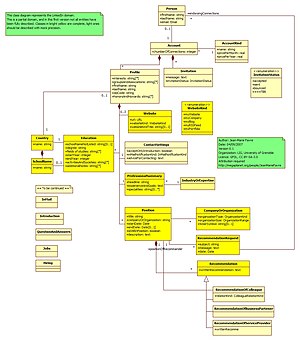LinkedIn: Difference between revisions
→Shortcomings: This is not really a short coming - what other service allows you to merge connections from diffferent profiles? |
|||
| Line 70: | Line 70: | ||
* Article with table of [http://www.antezeta.com/blog/social-networking-services/ business oriented social networking sites] including languages supported |
* Article with table of [http://www.antezeta.com/blog/social-networking-services/ business oriented social networking sites] including languages supported |
||
*[http://sequoiacap.com/company/linkedin/ LinkedIn Venture Capital Bio] |
*[http://sequoiacap.com/company/linkedin/ LinkedIn Venture Capital Bio] |
||
*[http://uk.intruders.tv/Essential-MediaTech-Keynote-Reid-Hoffman-of-LinkedIn_a247.html Reid Hoffman shares his thoughts on launching and growing a successful technology business] video |
|||
[[Category:Online social networking]] |
[[Category:Online social networking]] |
||
Revision as of 09:55, 27 November 2007
Type of site | Social network service |
|---|---|
| Created by | Dan Nye |
| Employees | 20 |
| URL | http://www.linkedin.com/ |
| Commercial | Yes |
LinkedIn is a business-oriented networking site (comparable to a social networking site), mainly used for professional networking. As of November 2007, it had more than 16 million registered users, spanning 150 industries and more than 400 economic regions (as classified by the service).
Company info
LinkedIn's CEO is Dan Nye, while former CEO Reid Hoffman, previously an Executive Vice President of PayPal, remains as President of Product and Chairman of the Board. LinkedIn is located in Mountain View, California, and funded [1]by Greylock, Sequoia Capital[2], Bessemer Venture Partners, and the European Founders Fund. LinkedIn reached profitability (positive cash flow) in March 2006.[3]
Web service features
The main purpose of the site is to allow registered users to maintain a list of contact details of people they know and trust in business. The people in the list are called Connections. Users can invite anyone (whether a LinkedIn user or not) to become a connection.
This list of connections can then be used in a number of ways:
- A contact network is built up consisting of their direct connections, each of their connections' connections (called second degree connections) and also the connections of second degree connections (called third degree connections). This can be used, for example, to gain an introduction to someone you wish to know through a mutual, trusted contact.
- It can then be used to find jobs, people and business opportunities recommended by anyone in your contact network.
- Employers can list jobs and search for potential candidates.
- Job seekers can review the profile of hiring managers and discover which of their existing contacts can introduce them.
The "gated-access approach" (where contact with any professional requires either a pre-existing relationship, or the intervention of a contact of theirs) is intended to build trust among the service's users. LinkedIn participates in the EU Safe Harbor Privacy Framework.
The feature LinkedIn Answers [4], similar to Google Answers or Yahoo! Answers, allows LinkedIn users to ask questions for the community to answer. "LinkedIn Answers" is free and the main differences from the two previously mentioned services are that questions are potentially more business-oriented, and the identity of the people asking and answering questions is known.
Model of the domain

The diagram on the right, expressed using the UML standard notation for class diagrams, represents a subset of the information managed by LinkedIn. It gives a global overview of the core entities, relations and fields stored by the system.
For instance, the diagram shows what fields are associated with the notion of Position, RecommendationRequest, Education and so on (see the corresponding boxes representing classes).
Note that this is a conceptual class diagram: it describes the concepts rather than the implementation and the details of the database.
Privacy issues
- Non-members can check whether or not you are a member, but as of August 2007, this can be disabled. [1]
- As of October 2006, there is no automated way to remove yourself from LinkedIn. The official method is to file a customer support ticket (see "Accessing and Changing Your Account Information" [2]). A possible workaround is to change your profile name to something unrelated to your real name.
Sites with comparable features
There are several websites that offer online business networking, including Ziggs, ryze, Doostang, XING, Plaxo and, increasingly Facebook. LinkedIn answers is comparable to Yahoo Answers. Various websites such as CareerBuilder.com and Monster.com have job search functions. Many websites have reputation systems and online social networking.
See also
- Social network
- Business network
- Social software
- List of social networking websites
- Information Routing Group
References
External links
- LinkedIn web site
- The LinkedIn Corporate Blog Describes LinkedIn community roles and activities.
- Lee Hill's "Living LinkedIn" Blog And Open Invitation Reports day-to-day appearances of LinkedIn in the news and how LinkedIn works in practice.
- TopLinked People on LinkedIn List of users with the most connections
- Article with table of business oriented social networking sites including languages supported
- LinkedIn Venture Capital Bio
- Reid Hoffman shares his thoughts on launching and growing a successful technology business video
